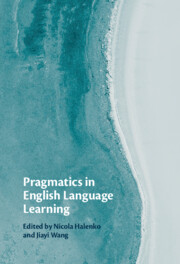Book contents
- Pragmatics in English Language Learning
- Pragmatics in English Language Learning
- Copyright page
- Contents
- Figures
- Tables
- Contributors
- Foreword
- Acknowledgements
- Introduction
- 1 Second Language Pragmatics
- Part I Pragmatics in Action
- 2 ‘Mind Your Language’
- 3 Pragmatic Development in Request Performance
- 4 Placing Oneself in the Reader’s Shoes
- 5 ‘Hey, You, Can I Loan Your Yellow Pencil?’
- Part II Instructed Pragmatics
- Index
- References
4 - Placing Oneself in the Reader’s Shoes
Developing Pragmatic Awareness of Perlocutionary Acts
from Part I - Pragmatics in Action
Published online by Cambridge University Press: 29 September 2022
- Pragmatics in English Language Learning
- Pragmatics in English Language Learning
- Copyright page
- Contents
- Figures
- Tables
- Contributors
- Foreword
- Acknowledgements
- Introduction
- 1 Second Language Pragmatics
- Part I Pragmatics in Action
- 2 ‘Mind Your Language’
- 3 Pragmatic Development in Request Performance
- 4 Placing Oneself in the Reader’s Shoes
- 5 ‘Hey, You, Can I Loan Your Yellow Pencil?’
- Part II Instructed Pragmatics
- Index
- References
Summary
This chapter investigates the perceived adequacy of the discourse of gratitude. It reports on a study in which questionnaires were administered to native speakers of English with experience as university lecturers. These questionnaires explored the envisaged impact on the addressee of foreign language learners’ written speech acts of thanking, the relevance of given textual-strategic features to the communicative effectiveness of speech acts of thanking, and the texts’ linguistic and textual problem areas relatable to the writers’ L1 background. The English lecturers expressed their likely cognitive, emotional, and behavioural responses to the learners’ writing, and indicated that they attributed importance to, and held the writers responsible for, logic and coherence, consideration of the addressee’s circumstances, and reader-friendliness. They identified two types of inadequacies: inaccuracy (e.g., deviations from linguistic norms), and inappropriateness (e.g., incongruity between text and co(n)text). The argument is put forward that language learners could enhance their interactional skills by adopting an other-oriented communicative perspective on their discourse, considering the interlocutor’s interactional rights, expectations, and foreseeable reactions.
- Type
- Chapter
- Information
- Pragmatics in English Language Learning , pp. 84 - 113Publisher: Cambridge University PressPrint publication year: 2022

